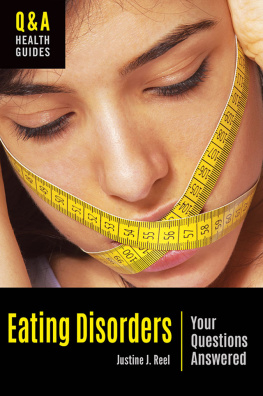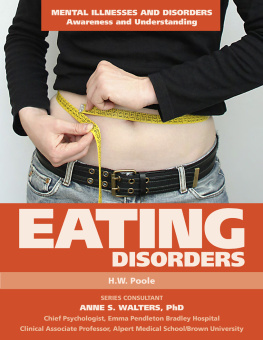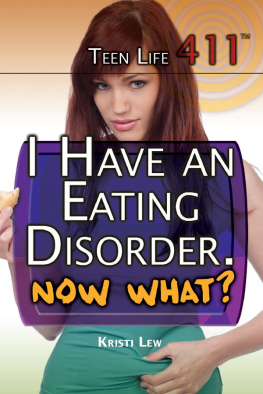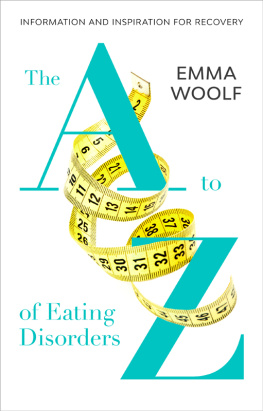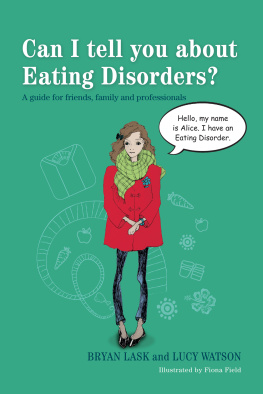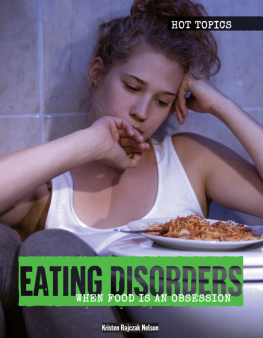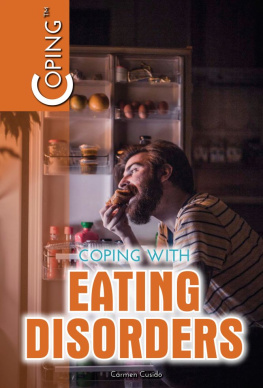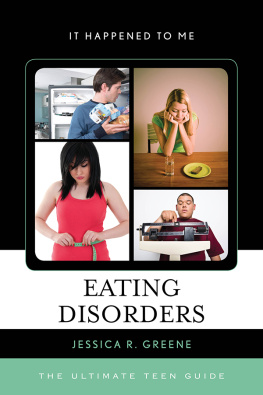Eating Disorders
Recent Titles in Q&A Health Guides
Self-Injury: Your Questions Answered
Romeo Vitelli
Living Green: Your Questions Answered
Amy Hackney Blackwell
Sexually Transmitted Diseases: Your Questions Answered
Paul Quinn
Mindfulness and Meditation: Your Questions Answered
Blaise Aguirre
Anxiety and Panic Disorders: Your Questions Answered
Daniel Zwillenberg
Substance Abuse: Your Questions Answered
Romeo Vitelli
EATING DISORDERS
Your Questions Answered
Justine J. Reel
Q&A Health Guides
Copyright 2018 by ABC-CLIO, LLC
All rights reserved. No part of this publication may be reproduced, stored in a retrieval system, or transmitted, in any form or by any means, electronic, mechanical, photocopying, recording, or otherwise, except for the inclusion of brief quotations in a review, without prior permission in writing from the publisher.
Library of Congress Cataloging-in-Publication Data
Names: Reel, Justine J., author.
Title: Eating disorders : your questions answered / Justine J. Reel.
Description: Santa Barbara, California : Greenwood, an imprint of ABC-CLIO, LLC,[2018] | Series: Q&A health guides | Includes bibliographical references and index.
Identifiers: LCCN 2018020375 (print) | LCCN 2018022081 (ebook) |
ISBN 9781440853050 (ebook) | ISBN 9781440853043 (alk. paper)
Subjects: LCSH: Eating disordersMiscellanea.
Classification: LCC RC552.E18 (ebook) | LCC RC552.E18 R432 2018 (print) | DDC 616.85/26dc23
LC record available at https://lccn.loc.gov/2018020375
ISBN: 978-1-4408-5304-3 (print)
978-1-4408-5305-0 (ebook)
22 21 20 19 18 1 2 3 4 5
This book is also available as an eBook.
Greenwood
An Imprint of ABC-CLIO, LLC
ABC-CLIO, LLC
130 Cremona Drive, P.O. Box 1911
Santa Barbara, California 93116-1911
www.abc-clio.com
This book is printed on acid-free paper 
Manufactured in the United States of America
This book discusses treatments (including types of medication and mental health therapies), diagnostic tests for various symptoms and mental health disorders, and organizations. The author has made every effort to present accurate and up-to-date information. However, the information in this book is not intended to recommend or endorse particular treatments or organizations, or substitute for the care or medical advice of a qualified health professional, or used to alter any medical therapy without a medical doctors advice. Specific situations may require specific therapeutic approaches not included in this book. For those reasons, we recommend that readers follow the advice of qualified healthcare professionals directly involved in their care. Readers who suspect they may have specific medical problems should consult a physician about any suggestions made in this book.
This book is dedicated to all eating disorder survivors and individuals
who continue to suffer from disordered eating and/or negative body
image. It is my hope that with greater awareness we can conquer and
prevent this harmful disease.
Contents
All of us have questions about our health. Is this normal? Should I be doing something differently? Who should I talk to about my concerns? And our modern world is full of answers. Thanks to the Internet, theres a wealth of information at our fingertips, from forums where people can share their personal experiences to Wikipedia articles to the full text of medical studies. But finding the right information can be an intimidating and difficult tasksome sources are written at too high a level, others have been oversimplified, while still others are heavily biased or simply inaccurate.
Q&A Health Guides address the needs of readers who want accurate, concise answers to their health questions, authored by reputable and objective experts and written in clear and easy-to-understand language. This series focuses on the topics that matter most to young adult readers, including various aspects of physical and emotional well-being, as well as other components of a healthy lifestyle. These guides will also serve as a valuable tool for parents, school counselors, and others who may need to answer teens health questions.
All books in the series follow the same format to make finding information quick and easy. Each volume begins with an essay on health literacy and why it is so important when it comes to gathering and evaluating health information. Next, the top five myths and misconceptions that surround the topic are dispelled. The heart of each guide is a collection of questions and answers, organized thematically. A selection of five case studies provide real-world examples to illuminate key concepts. Rounding out each volume are a directory of resources, glossary, and index.
It is our hope that the books in this series will not only provide valuable information but will also help guide readers toward a lifetime of healthy decision-making.
I would like to acknowledge the genuine support of my acquisitions editor, Maxine Taylor, my colleagues from around the world, and my friends and family. To my husband, Robert, thank you for your unwavering love and devotion. You are my rock.
Eating is a normal part of the human experience, and food has played an important role in our society throughout history. Although eating represents a basic need for survival and serves as fuel for the bodys systems, the meaning of food is much more complicated than a biological necessity. Eating can represent a popular and beloved pastime for individuals and families, but negative and unhealthy aspects of our relationship with food may also be present. To this end, eating behavior exists on a spectrum ranging from healthy to unhealthy. Both severe undereating or anorexia nervosa and overeating are represented with the disordered eating continuum.
The types of eating disorders recognized by the healthcare field and included in the current edition of the Diagnostic Statistical Manual of Mental Disorders are anorexia nervosa, bulimia nervosa, binge eating disorder, and feeding disorders such as avoidant-restrictive food intake disorder (ARFID). ARFID is represented by symptoms such as food avoidance, decreased appetite, and fear of vomiting or choking without the associated body image concerns. Causes of eating disorders are multifaceted and include genetics, psychological, and sociocultural factors. Body dissatisfaction and the perpetuation of the thinness ideal are strong predictors of disordered eating behavior.
Although eating disorders were not studied extensively until the 1980s and few treatment options existed before that decade, there was evidence of disordered eating an entire century prior. Specifically, anorexia nervosa was observed in the 1870s by two physicians who noted that their patients were avoiding food and appeared to have a loss of appetite. Currently, it is estimated that more than 10 million boys and men will develop eating disorders at some point in their lifetime. Males represent 10 to 25 percent of eating disorders, but these conditions often go undetected. By contrast, more than 20 million girls and women will suffer from eating disorders. Eating disorders are particularly common in the adolescent population, with anorexia nervosa representing the third most common chronic disease behind asthma and type 1 diabetes. It is estimated that a half million of teenagers exhibit disordered eating or meet the criteria for a full-blown eating disorder. This is problematic as eating disorders result in severe health consequences and are potentially life-threatening. Therefore, early detection and treatment are important for addressing eating disorders. This book attempts to answer common questions related to eating disorders across a variety of areasidentification, contribution, effects, and treatment.

